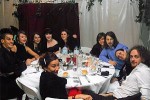 Après la palourde et le champagne, je voudrais vous parler d’un de ces dons de la nature bénie des dieux pour le plus grand plaisir de l’Homme : le diamant noir. Pour les moins connaisseurs, il s’agit de la truffe, merveille des sous-bois, mystérieuse folie aux mille saveurs, l’un des aliments sans doute les plus onéreux de la gastronomie française. Son prix varie en fonction de sa qualité ou de son abondance. Mais le kilo dépasse toujours le millier d’euros. Sait-on que le chiffre d’affaires de la truffe dans le monde atteint plusieurs milliards d’euros ? En France, il existe différents types de truffes comme la grise de Bourgogne ou la blanche d’Alba. Mais la plus célèbre reste la truffe noire du Périgord. Ce champignon souterrain vit en symbiose avec le chêne ou le noisetier. Il se nourrit de leurs matières organiques en décomposition. Quant à la renommée des truffes, elle repose toute entière sur leur complexité olfactive.
Après la palourde et le champagne, je voudrais vous parler d’un de ces dons de la nature bénie des dieux pour le plus grand plaisir de l’Homme : le diamant noir. Pour les moins connaisseurs, il s’agit de la truffe, merveille des sous-bois, mystérieuse folie aux mille saveurs, l’un des aliments sans doute les plus onéreux de la gastronomie française. Son prix varie en fonction de sa qualité ou de son abondance. Mais le kilo dépasse toujours le millier d’euros. Sait-on que le chiffre d’affaires de la truffe dans le monde atteint plusieurs milliards d’euros ? En France, il existe différents types de truffes comme la grise de Bourgogne ou la blanche d’Alba. Mais la plus célèbre reste la truffe noire du Périgord. Ce champignon souterrain vit en symbiose avec le chêne ou le noisetier. Il se nourrit de leurs matières organiques en décomposition. Quant à la renommée des truffes, elle repose toute entière sur leur complexité olfactive.
La truffe permet les recettes les plus simples (comme la brouillade ou le brie aux truffes), les plus surprenantes (la pizza aux truffes) aux plus subtiles (je garde un souvenir ému des œufs coque à la truffe de chez Faugeron). Et, souveraineté oblige, la truffe leur impose toujours son nom.
Et pour trouver cette noble pourriture, nul besoin de chien ou de porc dressé … De bons yeux et une bonne dose de patience suffisent : Il suffit de marcher très lentement, en laissant précautionneusement son ombre derrière soi, pour apercevoir, aussi bien les jours froids ensoleillés que par temps couvert ou doux,
la mouche à truffe (Suilla gigantea), généralement longue d’un centimètre, de couleur marron, posée sur le sol au-dessus de la truffe. Reste alors à caver la truffe, à l’extraire du sol, après avoir humé à pleines narines la terre, qui embaume, et à casser quelques œufs pour se pourlécher les babines d’une omelette qui vaut toutes les madeleines du monde.
Gastronomic gem: The Truffle
After clams and champagne, I would like to talk to you about one of these gifts of nature blessed by the Gods for the pleasure of Mankind: the ‘black diamond’. For those of you who don’t recognise the name, I am talking about the truffle, that marvel of the undergrowth and mysterious folly of a thousand flavours, which is undoubtedly one of the most expensive foodstuffs of French gastronomy. Its price varies according to its quality or its abundance but a kilo always costs more than a thousand Euros. Did you know that the turnover generated by truffles in the world reaches several billion Euros? In France, there are different types of truffle such as the grey truffle from Burgundy or the white truffle from Alba. But the most famous is the black truffle from the Périgord region. This underground mushroom lives in symbiosis with the oak tree or the hazel tree and feeds off their decomposing organic matter. Meanwhile the fame of truffles is entirely built upon the complexity of their fragrance.
The truffle can be used to grace anything from the simplest recipes (such as scrambled eggs or brie cheese), to the most surprising dishes (truffle pizza) and the most subtle (I have an emotional memory of boiled eggs topped with slivers of truffle served at the Restaurant Faugeron). And, given its star status, the truffle always steals the limelight in the name of the resulting dish.
And, to hunt out this noble piece of rot (!), there is no need for a trained dog or pig… A keen pair of eyes and a good dose of patience can do the trick. You just have to walk very slowly, ensuring that your shadow is behind you, to spot, whether on cold sunny days or cloudy mild days, the Suillia fly (Suilla gigantea), which is generally about a centimetre long, brown-coloured and sitting on the earth above the truffle. Then all you have to do is dig up the truffle, after sniffing the soil energetically to find it, and then break a few eggs to treat your taste buds to the best omelette ever.
Didier MOINEL DELALANDE







